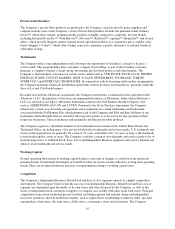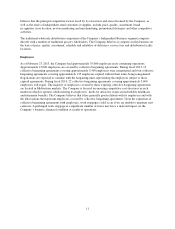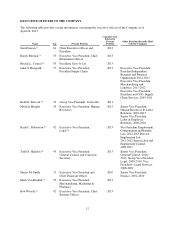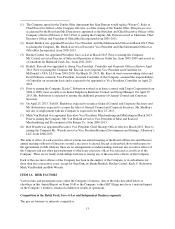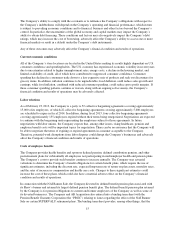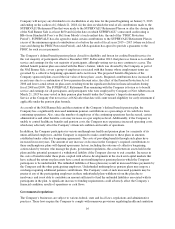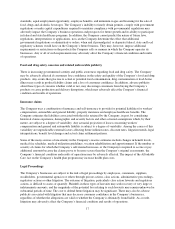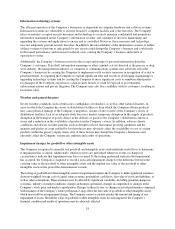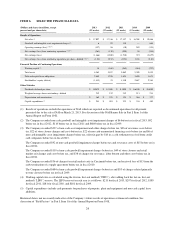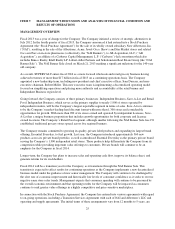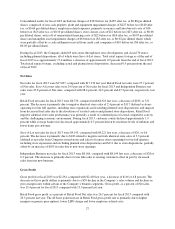Albertsons 2013 Annual Report Download - page 22
Download and view the complete annual report
Please find page 22 of the 2013 Albertsons annual report below. You can navigate through the pages in the report by either clicking on the pages listed below, or by using the keyword search tool below to find specific information within the annual report.ITEM 3. LEGAL PROCEEDINGS
The Company is subject to various lawsuits, claims and other legal matters that arise in the ordinary course of
conducting business. In the opinion of management, based upon currently-available facts, it is remote that the
ultimate outcome of any lawsuits, claims and other proceedings will have a material adverse effect on the overall
results of the Company’s operations, its cash flows or its financial position.
In September 2008, a class action complaint was filed against the Company, as well as International Outsourcing
Services, LLC (“IOS”), Inmar, Inc., Carolina Manufacturer’s Services, Inc., Carolina Coupon Clearing, Inc. and
Carolina Services, in the United States District Court in the Eastern District of Wisconsin. The plaintiffs in the
case are a consumer goods manufacturer, a grocery co-operative and a retailer marketing services company who
allege on behalf of a purported class that the Company and the other defendants (i) conspired to restrict the
markets for coupon processing services under the Sherman Act and (ii) were part of an illegal enterprise to
defraud the plaintiffs under the Federal Racketeer Influenced and Corrupt Organizations Act. The plaintiffs seek
monetary damages, attorneys’ fees and injunctive relief. The Company intends to vigorously defend this lawsuit,
however all proceedings have been stayed in the case pending the result of the criminal prosecution of certain
former officers of IOS.
In December 2008, a class action complaint was filed in the United States District Court for the Western District
of Wisconsin against the Company alleging that a 2003 transaction between the Company and C&S Wholesale
Grocers, Inc. (“C&S”) was a conspiracy to restrain trade and allocate markets. In the 2003 transaction, the
Company purchased certain assets of the Fleming Corporation as part of Fleming Corporation’s bankruptcy
proceedings and sold certain assets of the Company to C&S which were located in New England. Since
December 2008, three other retailers have filed similar complaints in other jurisdictions. The cases have been
consolidated and are proceeding in the United States District Court for the District of Minnesota. The complaints
allege that the conspiracy was concealed and continued through the use of non-compete and non-solicitation
agreements and the closing down of the distribution facilities that the Company and C&S purchased from each
other. Plaintiffs are seeking monetary damages, injunctive relief and attorneys’ fees. On July 5, 2011, the District
Court granted the Company’s Motion to Compel Arbitration for those plaintiffs with arbitration agreements and
plaintiffs appealed. On July 16, 2012, the District Court denied plaintiffs’ Motion for Class Certification and on
January 11, 2013, the District Court granted the Company’s Motion for Summary Judgment and dismissed the
case regarding the non-arbitration plaintiffs. Plaintiffs have appealed these decisions. On February 12, 2013, the
8th Circuit reversed the District Court decision requiring plaintiffs with arbitration agreements to arbitrate and
the Company filed a Petition with the 8th Circuit for an En Banc Rehearing.
On October 24, 2012, the Office of Self-Insurance Plans, a program within the director’s office of the California
Department of Industrial Relations (the “DIR”), notified the Company that additional security was required to be
posted in connection with the Company’s California self-insured workers’ compensation obligations of NAI, and
certain other subsidiaries pursuant to applicable regulations. The notice from the DIR stated that the additional
security was required as a result of an increase in estimated future liabilities, as determined by the DIR pursuant
to a review of the self-insured California workers’ compensation claims with respect to the applicable businesses,
and a decline in the Company’s net worth. A security deposit of $271 was demanded in addition to security of
$427 that was provided through the Company’s participation in California’s Self-Insurer’s Security Fund. The
Company appealed this demand. The California Self-Insurers’ Security Fund (the “Fund”) attempted to create a
secured interest in certain assets of NAI for the total amount of the additional security deposit. The dispute with
the Fund and the DIR has been resolved through a settlement agreement as part of the NAI Banner Sale on
March 21, 2013 and the primary obligation to the Fund and the DIR was retained by NAI following the NAI
Banner Sale.
Predicting the outcomes of claims and litigation and estimating related costs and exposures involves substantial
uncertainties that could cause actual outcomes, costs and exposures to vary materially from current expectations.
The Company regularly monitors its exposure to the loss contingencies associated with these matters and may
from time to time change its predictions with respect to outcomes and its estimates with respect to related costs
20


